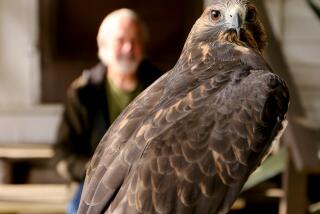She Goes to Bat for Flying Mammals
- Share via
WINSTED, Conn. — Pictures of bats decorate her walls. She fastens a golden bat clip in her hair. And in a small room in her home, Geraldine Griswold keeps 12 bats.
Call her batty. She doesn’t care.
As one of the state’s main bat rehabilitators, Griswold nurses hundreds of injured or abandoned bats back to health. She’s on a crusade to heal their reputations.
“We were raised on myths and legends. This animal was a pariah. It was never considered, and it was never studied,” she said.
On her shoulder, a brown bat snuggles close to her, sheltered by a black and orange blanket. Every few minutes, she peels the blanket back gently to ensure that it’s OK.
“What is there bad to say about a bat?” she queries, her eyes widening. She doesn’t understand the bad rap her flying friends have. To her, “they’re gentle, gentle creatures,” responsible for controlling the insect population and a host of other functions in nature.
Her true passion is at home, where she runs her bat hospital. Griswold, a traffic reporter for WTIC-AM in Hartford and part-time caterer, takes in bats that forget to migrate and become stranded for the winter, bats with broken wings or bats that have lost their mothers.
It started with the bat that rests on her shoulder, a female named Poppy. Griswold was walking outside her family’s Winsted home 10 years ago when she heard the newborn bat squeaking and found it on the ground. She took it in and fed it goat milk but didn’t expect it to survive the night.
It did.
“Three days later, she was cruisin’ for a bruisin’ and doing really well,” Griswold said.
But the bat was injured, unable to survive in the wild. Poppy was imprinted when she first opened her eyes and saw Griswold instead of her mother. Because she identifies with humans more than bats, Poppy has problems with basic bat functions like echolocating, a process where a bat bounces sonar off objects to avoid running into them.
“She doesn’t think she’s a bat; she’s a person,” Griswold jokes with a big laugh, pointing to her shoulder. “She has a broken mind.”
With no veterinary training or medical background, Griswold has attained much of her bat knowledge through tutelage. She worked with Audubon groups and contacted bat specialists throughout the country. She trades her success stories, and failures, through a network of other bat rehabilitators.
She brings bats to schools for education programs. A letter-writing campaign from schoolchildren and nature centers helped her get permits from the state Department of Environmental Protection to keep them in her home and take them out in public.
Griswold is one of four wildlife rehabilitators who specialize in bats in the state of Connecticut. Bat rehabilitation research is a relatively new field.
One of the reasons few people specialize in bats is because so little is known about them, said Jenny Dickson, a biologist who leads the state agency’s bat research.
“If you think about how long we’ve been mending broken wings on birds, you can look at books and papers and things that were written in the 1800s,” Dickson said. “You don’t start to get into a lot of information about people rehabilitating bats until the last 20 or 30 years.”
That is why people like Griswold are important, DEP officials said. Bats generally come into rehabilitation in small numbers, and fine-tuning the skills necessary to treat them can be challenging.
“It’s hard to become good at that if your only practice is one or two animals,” said Laurie Fortin, a wildlife technician with the state environmental agency. “The people who specialize tend to gain the most experience and have the most success.”
Each bat that comes to Griswold has a story that veterinarians or biologists often can’t tell. She doesn’t know how old all of her bats are. Treatment is often a mystery, or an instinctual guessing game.
Take Jiggy. The silver-haired bat came to her with a broken wing, but she didn’t know how it got that way. Because his wing is so small, it couldn’t be set. There’s nothing she could do but make him comfortable.
When a group of Egyptian fruit bats were mysteriously dying of liver failure, she couldn’t find anyone to draw their blood to help her diagnose the problem. She tried changing their diet, and it worked.
“What is great for me is that I can make as much of an impact as someone with a PhD,” she says, feeding another one of her bats a squiggling worm with a pair of silver tweezers.
More to Read
Sign up for Essential California
The most important California stories and recommendations in your inbox every morning.
You may occasionally receive promotional content from the Los Angeles Times.













